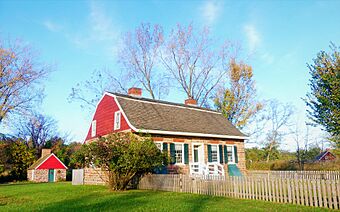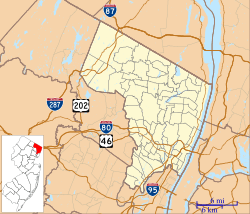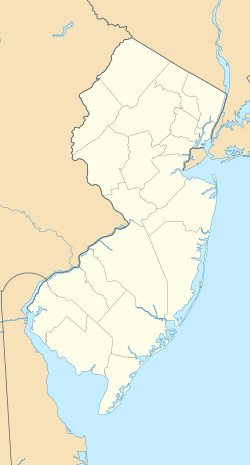Campbell-Christie House facts for kids
|
Campbell-Christie House
|
|
|
U.S. Historic district
Contributing property |
|

Campbell-Christie House in 2021
|
|
| Location | 1201 Main Street River Edge, New Jersey |
|---|---|
| Built | c. 1774 |
| Part of | Steuben Estate Complex (ID80004403) |
| MPS | Early Stone Houses of Bergen County |
| NRHP reference No. | 83001481 |
Quick facts for kids Significant dates |
|
| Added to NRHP | January 10, 1983 |
| Designated CP | December 9, 1980 |
The Campbell-Christie House is an old house with a lot of history. It was moved to a special place called New Bridge Landing in River Edge, New Jersey. This town is in Bergen County, New Jersey.
This house became a protected historic site on January 10, 1983. It's part of a group of important stone houses in Bergen County.
Contents
History of the Campbell-Christie House
Early Owners and the Revolution
Around 1774, a stonemason named Jacob Campbell built this house. It was a store and also his home. He built it in New Milford, New Jersey, when he married Altche Westervelt. The house was on land owned by his father, William Campbell. His father ran a tavern nearby.
Jacob Campbell was a soldier during the American Revolution. His property was damaged during the war. However, records from 1780 show he was still a merchant. After his father passed away in 1793, Jacob sold the house to Abraham Brower.
The Christie Family and a Famous Inventor
In 1795, a blacksmith named John D. Christie bought the house. He paid £250 for it. John D. Christie turned the house into a tavern. When he passed away in 1836, he left the house to his son, John J. Christie, who was a farmer. Later, the house went to Jacob Brinkerhoff Christie. He managed a company called Comfort Coal & Lumber Company.
A very famous inventor, J. Walter Christie, was born in this house on May 6, 1865. He was a mechanical genius. When he was 16, he worked on early submarines. He also helped design parts for battleships.
J. Walter Christie loved cars. He built and raced them, even setting speed records. In 1907, he was badly hurt in a car crash. Later, he invented front-wheel drive for cars. This invention was used in fire trucks. But he is most famous as the "father of the modern tank." He passed away in 1944.
Saving the Historic House
In 1908, the Brookchester Land Company made many changes to the house. Years later, in 1977, the house was going to be torn down. The Bergen County Historical Society stepped in to save it. This group is a non-profit organization run by volunteers.
They made a deal with Bergen County. The Historical Society would get to use the house and restore it. In return, the County would pay for utilities and keep the house in good shape. A county leader, D. Bennett Mazur, helped a lot to save the house.
With a grant of $150,000, the 200-year-old house was moved. It traveled two miles from New Milford, New Jersey to River Edge. This happened in September 1977. The area where it was moved is now called Historic New Bridge Landing.
The House Today
Today, the Bergen County Historical Society takes care of the Campbell-Christie House. They have furnished it to look like an 18th-century tavern. This helps visitors imagine what life was like back then.
In 1992, a special kitchen was built behind the house. It's a working copy of an old "Jersey Dutch Out Kitchen." The Historical Society often opens the Campbell-Christie House and other buildings at Historic New Bridge Landing for special events. They work with the Historic New Bridge Landing Park Commission.
The Bergen County Historical Society does not get money from the government to operate. They rely on people becoming members and giving donations.
See also
- National Register of Historic Places listings in Bergen County, New Jersey
- List of the oldest buildings in New Jersey




